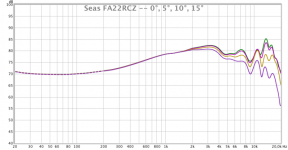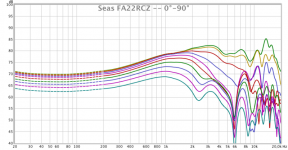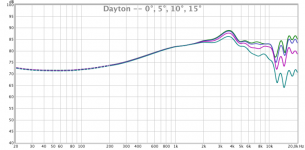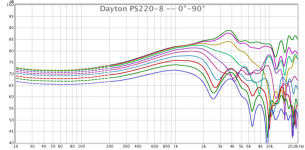Copy of doc I send out with BMR drivers.
I get asked loads of questions about how best to build cabinets for the 4.5 inch Neo Magnet BMR's and I send out a standard document with a bunch of tips... I tried to attach it as a word doc but it wont load for some reason?
Here is a copy if you are going to experiment with the drivers.
" Design suggestions for the CIA 4.5 inch Neo BMR "
" Both the rubber surround and fabric surround CIA 4.5 inch Neo BMR drivers are very flexible full range drivers which can be used in a wide range of applications and cabinet designs. From desk top or small surround speakers to full range ultra-high performance line arrays and mastering studio grade monitors.
The drivers perform best in sealed box applications and are optimised for sealed air volumes approx. 2 litres to 4 litres. Two litres sealed is a great start, with some gains in efficiency and bass extension when increased to 3 or 4 litre air volumes.
The rubber surround versions can be run full range in any sealed design from singles to massive panel designs. The fabric surround version is a highly specialised driver designed for use above 140 Hz when crossed over to arrays of our rubber surround BMR.
For the valve and vinyl audio purist, the drivers can be combined in line arrays to create very sensitive (94dB to 98dB / 1 watt @ 1 meter) high impedance (10 Ohm to 24 Ohm) designs which can be run full range with no crossover and no Eq at all.
For ultra-high performance studio monitors, critical listening and dedicated home cinema installations the drivers can be Eq’d to allow for speaker location i.e. in wall / on wall soffit mounting, near field monitors or floor standing monitors.
We do not recommend open baffle applications. The drivers need the loading of a sealed box to control low frequency cone motion. There is a high risk of damaging the driver when used in open baffle and over driving is not covered by our warranty!
When using computer based sources, fine tuning of the sound is easily achieved with modern Eq. We recommend both Blue Cat Audio Welcome to Blue Cat Audio - Professional Audio Plugins (VST, RTAS, AAX, Audio Unit, DirectX) and Fab Filter FabFilter - Quality Audio Plug-Ins for Mixing, Mastering and Recording - VST VST3 AU AAX RTAS AudioSuite as studio grade solutions, for home use we recommend you use the built in Eq that comes with all good media hosts such JRiver.
For low to medium SPL applications such as casual listening, PC speakers, home cinema surround sound etc. the drivers can be run full range with no Eq. As most AV receivers and media hosts (JRiver, iTunes etc.) have Eq built in you can use this to boost the low end and / or compensate for speaker location i.e. on wall, in corners, desk top etc.
As SPL and dynamic range requirements increase the drivers can be combined in groups and line arrays to create true full range, zero crossover loudspeaker systems to meet the most demanding requirements. We have had astonishing results with both two channel and multi-channel systems using 18 to 48 drivers per cabinet.
Design & construction suggestions for DIY builds:
(1) Internal cabinet wall damping material is vital, a good 2mm or 3mm of bitumen type material should cover 100% of the internal cabinet walls. In addition we recommend Twaron or “Angel Hair” internal damping material, approx.10 g per driver. This is well worth the extra cost compared to fibre glass! Please note all the Twaron must be sealed in a thin cotton or silk bag to avoid the tiny fibres getting into the voice coil of the driver.
(2) The driver needs two litres or air after the allowance for cabinet damping and the air volume the driver itself takes up. I.e. Use a 3 litre internal cabinet volume and then allow for the damping materials plus driver take up 0.8 litres so each BMR gets approx 2.2 litres of clear air.
(3) The drivers do need about 50 hours running in….Some Maxwell from his “Embra” album at good volume does the trick…Enough to get about plus / minus 2mm cone movement.
(4) We recommend crimping all joints (not solder) and use solid core silver (0.6mm to 0.8mm diameter) cable to wire the speakers. Multi stranded copper cable and solder are bad news for signal quality, especially in Line Arrays where you have 8, 16, 32 or even 48 drivers per cabinet. "
Hope this helps.
Cheers
Derek.
I get asked loads of questions about how best to build cabinets for the 4.5 inch Neo Magnet BMR's and I send out a standard document with a bunch of tips... I tried to attach it as a word doc but it wont load for some reason?
Here is a copy if you are going to experiment with the drivers.
" Design suggestions for the CIA 4.5 inch Neo BMR "
" Both the rubber surround and fabric surround CIA 4.5 inch Neo BMR drivers are very flexible full range drivers which can be used in a wide range of applications and cabinet designs. From desk top or small surround speakers to full range ultra-high performance line arrays and mastering studio grade monitors.
The drivers perform best in sealed box applications and are optimised for sealed air volumes approx. 2 litres to 4 litres. Two litres sealed is a great start, with some gains in efficiency and bass extension when increased to 3 or 4 litre air volumes.
The rubber surround versions can be run full range in any sealed design from singles to massive panel designs. The fabric surround version is a highly specialised driver designed for use above 140 Hz when crossed over to arrays of our rubber surround BMR.
For the valve and vinyl audio purist, the drivers can be combined in line arrays to create very sensitive (94dB to 98dB / 1 watt @ 1 meter) high impedance (10 Ohm to 24 Ohm) designs which can be run full range with no crossover and no Eq at all.
For ultra-high performance studio monitors, critical listening and dedicated home cinema installations the drivers can be Eq’d to allow for speaker location i.e. in wall / on wall soffit mounting, near field monitors or floor standing monitors.
We do not recommend open baffle applications. The drivers need the loading of a sealed box to control low frequency cone motion. There is a high risk of damaging the driver when used in open baffle and over driving is not covered by our warranty!
When using computer based sources, fine tuning of the sound is easily achieved with modern Eq. We recommend both Blue Cat Audio Welcome to Blue Cat Audio - Professional Audio Plugins (VST, RTAS, AAX, Audio Unit, DirectX) and Fab Filter FabFilter - Quality Audio Plug-Ins for Mixing, Mastering and Recording - VST VST3 AU AAX RTAS AudioSuite as studio grade solutions, for home use we recommend you use the built in Eq that comes with all good media hosts such JRiver.
For low to medium SPL applications such as casual listening, PC speakers, home cinema surround sound etc. the drivers can be run full range with no Eq. As most AV receivers and media hosts (JRiver, iTunes etc.) have Eq built in you can use this to boost the low end and / or compensate for speaker location i.e. on wall, in corners, desk top etc.
As SPL and dynamic range requirements increase the drivers can be combined in groups and line arrays to create true full range, zero crossover loudspeaker systems to meet the most demanding requirements. We have had astonishing results with both two channel and multi-channel systems using 18 to 48 drivers per cabinet.
Design & construction suggestions for DIY builds:
(1) Internal cabinet wall damping material is vital, a good 2mm or 3mm of bitumen type material should cover 100% of the internal cabinet walls. In addition we recommend Twaron or “Angel Hair” internal damping material, approx.10 g per driver. This is well worth the extra cost compared to fibre glass! Please note all the Twaron must be sealed in a thin cotton or silk bag to avoid the tiny fibres getting into the voice coil of the driver.
(2) The driver needs two litres or air after the allowance for cabinet damping and the air volume the driver itself takes up. I.e. Use a 3 litre internal cabinet volume and then allow for the damping materials plus driver take up 0.8 litres so each BMR gets approx 2.2 litres of clear air.
(3) The drivers do need about 50 hours running in….Some Maxwell from his “Embra” album at good volume does the trick…Enough to get about plus / minus 2mm cone movement.
(4) We recommend crimping all joints (not solder) and use solid core silver (0.6mm to 0.8mm diameter) cable to wire the speakers. Multi stranded copper cable and solder are bad news for signal quality, especially in Line Arrays where you have 8, 16, 32 or even 48 drivers per cabinet. "
Hope this helps.
Cheers
Derek.
Pardon my ignorance but how does that answer the question?
Did you see the pics of Overkill Audio? You stated you couldn't find anything about them.
Did you see the pics of Overkill Audio? You stated you couldn't find anything about them.
I've said "I did search for user "Overkill Audio" and "BMR" but nothing matching my requirements came up."
Really appreciate that you're trying to be helpful but I know how to use search
There is the Dayton PS-220 that has the SPL capability you seek as it is 95dB sensitive. It can probably be EQ'd smooth if you have PEQ. Are you ok with that one? Look at the curve and specs and if you like it I can design a box for HT around it for you. The Tang Band W8-1772 is also worth looking at.
Would you be opposed to a 80Hz to 9kHz "semi-fullrange" and letting a super tweeter cover above 9kHz? Most vocals, spatial cues, etc are covered in this range. If you are ok with his approach there is a 100dB sensitive 8in pro audio driver from PRV that is in the same family as the 5MR450-NDY that I really like. I would recommend that but it doesn't reach 80Hz easily. Here is the driver I am talking about: PRV Audio 8MR500-NDY-4 8" Neodymium Midrange Woofer 4 Ohm
Want to achieve a simple full range solution without crossovers (other than the high pass and equalization).
The Dayton looks interesting. Anbody got off axis measurements?
$560
I've said "I did search for user "Overkill Audio" and "BMR" but nothing matching my requirements came up."
Really appreciate that you're trying to be helpful but I know how to use search
You also asked for a direct link after that statement. The second link has a BMR post.
You also asked for a direct link after that statement. The second link has a BMR post.
No
You also asked for a direct link after that statement. The second link has a BMR post.
As I learned the hard way, once you leave the search, it's gone, so have to copy the exact link you want to paste elsewhere.
GM
The Dayton looks interesting. Anbody got off axis measurements?
There is some polar data in spec sheet - they don't label but I think probably 0deg, 30deg, 60deg?
http://www.daytonaudio.com/media/resources/295-346-dayton-audio-ps220-8-brochure-9530.pdf
There is some polar data in spec sheet - they don't label but I think probably 0deg, 30deg, 60deg?
Considering how steep that cone is, I'll guess it's more like 0 deg, 15 deg, 30 deg....
What about the old W8-1772? Has anyone compared it to the Dayton? The Dayton is going to be less efficient after EQ'ing those BIG peaks down to flat. That driver looks most suited to a front horn to me.
Back to the OP: any number of reflex/TL/sealed box appropriate full range drivers will work for this application. Just make the box shallow.
Partial list off the top of my head:
Alpair 12P
TB W8-1772
Seas Prestige FA22RCZ
Fostex FF225WK (+supertweeter)
Dayton Audio PS220-8 (+EQ)
Betsy K
L. Cao
Audio Nirvana
or go cheap with one of these:
GRS 8FR8 BOFU clone
Visaton BG20
Goldwood BOFU clone
Or get a home hifi coax like the SEAS Prestige T18REX/XFC
Frankly, if you can budget it, I would probably do the last option if this is intended mostly for HT. Box will be small, sound will be smooth, it will be more forgiving of HT receiver electronics, and Madisound has a ready made crossover available.
Note that I've only recommended point source drivers. I'm not a huge fan of full range line arrays myself, though they do have some advantages.
As I learned the hard way, once you leave the search, it's gone, so have to copy the exact link you want to paste elsewhere.
GM
You're right! Here you go spkr!
http://www.diyaudio.com/forums/full-range/191853-near-full-range-bmr-balanced-mode-radiator.html
You're right! Here you go spekr!
http://www.diyaudio.com/forums/full-range/191853-near-full-range-bmr-balanced-mode-radiator.html
There is some polar data in spec sheet - they don't label but I think probably 0deg, 30deg, 60deg?
http://www.daytonaudio.com/media/resources/295-346-dayton-audio-ps220-8-brochure-9530.pdf
It's a shame that manufacturers don't publish high resolution polar data. How should the consumer decide which driver best suits his requirements?
I've ordered the PS220. Should have it next week.
Visaton BG20
That driver drops like a stone above 10kHz. I've found this on the internet.
An externally hosted image should be here but it was not working when we last tested it.
Good to see you are moving forward with the PS220. It has a very thin cone so does not like back reflections which can come back and color sound. Needs good absorbent damping behind driver.
Some manufacturers like B&C provide lots of info. Look at the page for their 6FHX51 6.5in coax for example. More polar data and other info normally not seen.
B&C Speakers

Some manufacturers like B&C provide lots of info. Look at the page for their 6FHX51 6.5in coax for example. More polar data and other info normally not seen.
B&C Speakers

Hi xrk971,
Professional speaker manufacturers generally seem to be more generous with publishing data. I wonder why that is. Professionals probably know that speaker building is an engineering effort that requires good data?
Nevertheless I find those normalized polars from B&C hard to read. It would hide important performance data like the huge drop in HF energy in the data of a Visaton BG 20 that I just posted. Maybe normalized and not normalized graphs side by side would be best.
Professional speaker manufacturers generally seem to be more generous with publishing data. I wonder why that is. Professionals probably know that speaker building is an engineering effort that requires good data?
Nevertheless I find those normalized polars from B&C hard to read. It would hide important performance data like the huge drop in HF energy in the data of a Visaton BG 20 that I just posted. Maybe normalized and not normalized graphs side by side would be best.
Good to see you are moving forward with the PS220.
The driver arrived. I had also ordered a Seas FA22RCZ. Here're some measurements of each driver in a 48l test box. Impulse response window is 4ms.
The Dayton looks great. The only flaw seems to be the dip at 11.5kHz. Any thoughts?
Anybody measured the Alpair 12P, Betsy K, Audio Nirvana?
Attachments
- Home
- Loudspeakers
- Full Range
- Full range on wall for home theater?



